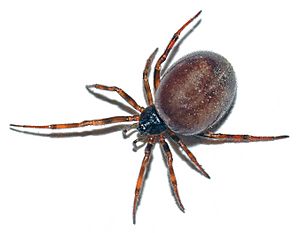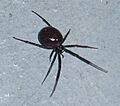Steatoda facts for kids
Quick facts for kids Steatoda |
|
|---|---|
 |
|
| Female Steatoda bipunctata | |
| Scientific classification | |
| Species | |
| Diversity | |
| 118 species |
The Steatoda is a group of spiders, also known as false widows or cupboard spiders. There are about 120 different kinds of Steatoda spiders found all over the world. Many of them live near people, in houses or gardens.
They are called cupboard spiders because they often build their webs in quiet, dark spots. You might find their webs in sheds, garages, or under garden furniture. A sign that a cupboard spider lives nearby is small white spots on the floor. These spots are spider droppings, which look a bit like tiny paint splashes.
Many Steatoda spiders are called false widows because they look a lot like the famous black widow spiders. They are related to black widows, but Steatoda spiders are much less dangerous to humans. Not all Steatoda spiders look like black widows. They come in many colors and sizes. Most are smaller than black widows. For example, Steatoda paykulliana can be bigger, and Steatoda castanea looks more like a brown widow.
Like other spiders in their family (Theridiidae), Steatoda spiders often eat other spiders. They can even catch spiders that are thought to be dangerous to humans. For instance, Steatoda grossa sometimes preys on black widows.
Contents
What Do Steatoda Spiders Look Like?
Steatoda spiders can be many colors. They range from light sandy brown to reddish purple or shiny black. Like most spiders, their front body part, called the cephalothorax, is smaller than their back part, the abdomen. The abdomen is shaped a bit like an egg.
Their abdomens can have white, beige, or orange markings. These marks often include a crescent shape at the front. They might also have a line or triangle shapes on their back. Some Steatoda paykulliana spiders have orange or reddish marks. These can make them look like the redback spider.
How Steatoda Spiders Build Webs and Hunt
Steatoda spiders build messy, tangled webs. These webs are made of sticky silk threads. Like other spiders that build webs, Steatoda spiders cannot see very well. They rely on vibrations that travel through their webs. These vibrations tell them when prey is caught or when a larger animal is nearby. This helps them find food or escape danger.
Common Steatoda Species You Might See
There are many types of Steatoda spiders. Here are some of the well-known ones:
- S. borealis: This spider is common in North America. People often mistake it for a black widow. However, it is smaller and has colored marks on the top of its abdomen, not underneath.
- S. capensis: Also called the black cobweb spider. It comes from South Africa and is now found in Australia and New Zealand. In New Zealand, it is sometimes confused with the katipo spider.
- S. grossa: This spider is often called the cupboard spider. It is dark and looks like some black widows. But it does not have the bright marks that most black widows have. This spider is known to sometimes eat real black widows. Bites from S. grossa can cause symptoms similar to black widow bites, but they are much less serious. This spider started in Europe but is now found worldwide.
- S. nobilis: This spider is from the Canary Islands. It has spread to the United Kingdom and other parts of Europe. Its bite can be painful, but it is usually no worse than a wasp sting.
- S. paykulliana: This spider is also often confused with black widows. It is found in the same areas as the Latrodectus tredecimguttatus spider. Its bite can cause some medical symptoms, but it is not serious.
Other Notable Steatoda Spiders
- S. bipunctata: A common house spider found in Europe.
- S. triangulosa: Known as the triangulate cobweb spider. It is a common house spider with a cool pattern of triangles on its back. It is not known to bite humans and is found all over the world.
- S. hespera: Called the western bud spider. This spider lives in the western United States and Canada. It is good at hunting hobo spiders. People sometimes confuse it with the black widow, but it is much smaller (7 to 8 mm) and has no bright marks. It is not known to bite humans.
What Do Steatoda Spiders Eat?
Steatoda spiders are known to eat other spiders, including real black widows. They also munch on crickets, ladybugs, cockroaches, and woodlice.
Steatoda Spider Bites: What to Know
Some Steatoda spiders, like S. grossa and S. nobilis, can bite humans. Their bites can cause some symptoms, but they usually do not have any long-lasting effects. You might see a blister where the bite happened. You might also feel generally unwell for a few days.
Symptoms can include pain that gets stronger for about an hour. Some people feel a little sick to their stomach, have a headache, or feel tired. All these symptoms usually go away within 1 to 60 hours.
Doctors have a name for the symptoms caused by Steatoda bites: steatodism. It is like a milder version of latrodectism, which is what happens when a black widow spider bites you.
Steatoda spiders are not aggressive. Most of the time, if a human gets bitten, it is because the spider was accidentally squeezed or pinched. Sometimes, a spider might bite if it thinks a finger poked into its web is food. But usually, if a large creature comes near, these spiders will try to run away.
Images for kids
See also
 In Spanish: Steatoda para niños
In Spanish: Steatoda para niños






